The payroll tax that funds Social Security, Medicare and Disability Insurance, called FICA (Federal Insurance Contributions Act), is already the largest tax most American families pay. In the future, it will claim an even greater share of Americans' incomes. From its current level of 15.3 percent (combining the employer and employee shares), the payroll tax will need to rise above 25 percent of workers' incomes by the middle of the century in order to pay benefits to today's teenagers when they retire.
Adding this tax to other taxes on labor income results in a surprisingly high marginal tax rate for average-income families:
- When all taxes on labor income are combined, the average American family faces a 44 percent marginal tax rate.
- This implies that, on the average, families get to keep only 56 cents out of each additional dollar they earn.
Because of the growing burden of elderly entitlement programs, these tax rates are expected to rise through time:
- By 2050, when today's teenagers reach retirement age, the marginal tax rate the average family faces will be 53 percent.
- If the system is not changed, by the time today's newborns retire, taxpayers will keep only about 40 cents of every additional $1 they earn.
These very high tax rates cause economic harm. The current system encourages people to work fewer hours and produce fewer goods and services, relative to an efficient tax system. We estimate that:
- The cost to society as a whole from the Social Security payroll tax alone is between 11 cents and 18 cents for every dollar of tax revenue collected.
- For society as a whole, this loss amounted to between $49 billion and $82 billion in 2001, an amount equal to as much as $804 for every household in America.
Looking to the future, we find that the payroll tax required to pay benefits will rise and the cost of the tax to the country as a whole will rise even faster:
- By the time today's teenagers reach the retirement age in 2050, the nation will be sacrificing as much as 30 cents for every dollar collected in payroll taxes.
- By the time today's newborns retire in 2070, the cost to society as a whole will be as much as 34 cents for every dollar collected.
One way to avoid these high costs is to move to a system that requires people to save for their own retirement, instead of paying taxes to support the retirement of others. Such a mandatory savings program would not discourage people from working because they would get to keep every dollar they earned.
We have examined several ways of reforming the current system, including complete privatization. However, even a totally privatized system must include a mechanism for funding the benefits people have already earned under the current system. One way is to issue bonds to people (equal to the present value of their already earned benefits) and to pay interest on the bonds with revenue from a payroll tax. Another way is to use the payroll tax to pay accrued benefits directly. Either alternative will provide big gains for the country as a whole:
- Under the bond approach, by mid-century the reformed system will have reduced the annual cost of the payroll tax by 60 percent.
- Under the tax approach, by mid-century the reformed system will have lowered the annual cost by 72 percent.
The Bush administration and Congress are discussing a more limited reform that would allow workers to deposit 2 percentage points of their Social Security payroll tax in a personal retirement account (PRA). Over time, PRA accumulations would partially replace Social Security benefits, leaving total benefits virtually unchanged. Even this limited reform will have a substantial payoff:
- By mid-century, the reform will have reduced the economic losses of the current system by almost one-third.
- By the time today's newborns reach retirement, it will have reduced the losses by more than half.
This report focuses on only one of the social costs of pay-as-you-go Social Security. There are also other costs. For example, the payroll tax encourages employers and employees to substitute non-taxed fringe benefits for taxable wages. It also induces workers to save less than they otherwise would because (a) Social Security promises are a substitute for private savings and (b) the payroll tax leaves them with less income from which to save. These distortions also have economic costs. When all costs are considered:
- The total cost to society of operating our Social Security system was as high as $328 billion last year.
- To put this in perspective, the U.S. government spent $439 billion on Social Security retirement benefits last year.
Roughly speaking, for every four dollars the system pays out in benefits, society as a whole bears up to a three dollar cost.
[page]Social Security is an income transfer program that takes money from some and gives it to others. To that extent, one person's gain is another's loss. In the process of transferring income from some to others, certain social costs arise. These costs make society as a whole worse off. In general, three separate costs arise as a result of Social Security's existence and payroll tax financing:
- The Social Security payroll tax makes work and production less attractive relative to an efficient way of raising the same revenue.
- Because wages are subject to the tax while benefits are not, the Social Security payroll tax causes a shift from taxable wages to fringe benefits, a shift that leaves workers with a less desirable compensation package.
- The Social Security system also encourages people to save less because (1) the payroll tax leaves workers with less disposable income from which to save and (2) Social Security benefits remove an important reason for people to save.
"There are hidden costs of Social Security."
These are the hidden costs of Social Security. This paper focuses on the first of these: the labor supply distortion caused by the Social Security payroll tax. With respect to these costs the theory is less controversial and there is a greater consensus on the empirical magnitude of the parameters involved. A payroll tax results in fewer hours of work than would a lump-sum tax that generates the same tax revenues. (A lump-sum tax is one that does not vary according to the amount of work.) Economists call these losses "welfare losses." The welfare loss of a tax system is the extra burden it imposes on taxpayers, over and above the revenue collected by government.
[page]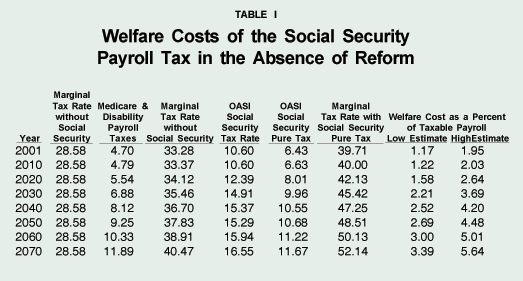
The formulas used to estimate the welfare loss are presented in the Appendix, but the basic intuition is that a payroll tax on labor income does two things: (1) it lowers individuals' willingness to work and (2) it lowers their discretionary income. These two effects work in opposite directions in terms of the impact on the number of hours people work. A tax on labor reduces the value of working another hour because people get to keep less of what they earn. Taken by itself, this effect tends to lower the number of hours individuals work. But because the tax also lowers income, workers tend to work more hours in order to replace at least part of that loss.1
The welfare loss arises from the first effect, not the second. The measure of this loss tells us how much worse off individuals are with the Social Security tax relative to a tax that raises the same revenue but does not distort labor supply decisions. Calculating the welfare loss requires estimates of how responsive workers are to changes in their wages and the levels of the various taxes on labor. To isolate the cost of the Social Security tax, we must first identify the welfare loss associated with all other labor taxes, then calculate the additional welfare loss that arises when the Social Security tax is imposed.
Direct and Indirect Taxes on Income. We begin with the weighted-average marginal tax rate on labor income from the federal income tax. We use an average of the marginal tax rates paid of 20.15 percent. This was the weighted average marginal tax rate paid in 1999 across all tax returns categorized by adjusted gross income categories.2
"The payroll tax imposes a burden over and above any revenues the government collects."
Since state income taxes yield about 20 percent as much revenue as the federal tax and use much the same tax base, we assume they increase the marginal tax rate on labor income by 20 percent of the federal marginal rate, or 4.03 percent. We treat sales and excise taxes as a uniform levy on labor income (and other income) at a rate of 4.4 percent, since that is their percentage of national income. All these direct and indirect levies on labor income together amount to a combined marginal tax rate on labor income of 28.58 percent. This rate is shown in the second column of Table I.
Other Payroll Taxes. The Medicare tax rate is currently 2.9 percent and the Disability Insurance tax rate is 1.8 percent. Since these rates are not high enough to maintain the programs' solvency, they are expected to increase over time. Adding the Medicare and Disability Insurance tax rates to the second column gives us the combined marginal tax rates for various years, shown in the fourth column of Table I.
The Social Security Payroll Tax. The Social Security payroll tax is the second-largest tax in the United States, following the federal individual income tax. The Old-Age and Survivors Insurance (OASI) component alone is 10.6 percent. Like Medicare and Disability Insurance, OASI will require additional funding in the future.3 To close the financing gap, we estimate that, beginning in 2017, the OASI payroll tax rate will have to increase to pay annual benefits.4 Adding this tax to other taxes on labor income results in a surprisingly high marginal tax rate for average income families:5
- When all taxes on labor income are combined, the average American family faces a 44 percent marginal tax rate.
- This implies that, on the average, families get to keep only 56 cents out of each additional dollar they earn.
- By 2050, when today's teenagers reach the retirement age, the average family will face a marginal tax rate of 53 percent.
- If the tax system is not changed, by the time today's newborns retire, taxpayers will get to keep only 40 cents out of every additional $1 they earn.
"When all taxes are considered, the average family gets to keep only 56 cents out of each additional $1 of earnings."
Estimating the Pure Social Security Payroll Tax. In general, only a loose relationship exists between the Social Security tax paid on a marginal dollar earned as wages and the incremental Social Security benefit produced by that tax. The strength of the relationship declines as income rises. One could argue that the average worker sees little relationship between taxes paid and benefits received, at the margin. However, to the extent that workers perceive they are getting back benefits directly related to the taxes they pay, they will not view the tax as a total loss. Instead, the net burden is the tax minus any perceived benefits the tax generates. Economists call this net tax a "pure tax."
One way to measure this net burden is to compare the rate of return workers can expect to receive on their payroll tax dollars with the rate of return they could have earned had those tax dollars been invested in the capital market instead. When the rate of return on Social Security tax payments is less than the market rate of return, a portion of workers' taxes are pure taxes. In what follows, we assume that the real return on capital, taking into account corporate taxes, is 5.4 percent.6 In contrast, the real rate of return from a mature, pay-as-you-go Social Security system is the growth rate of the Social Security payroll tax base, which in the long run is only about 1.3 percent.7
"By the time today's newborns retire, taxpayers will get to keep only 40 cents out of every additional $1 they earn."
Suppose a worker is taxed $1 and 35 years later the government returns to the worker an amount equal to the $1 plus annual compounded interest payments of 1.3 percent. The total will be $1.57. But how much would we need to invest today at the market rate of return of 5.4 percent to arrive at the same $1.57? The answer is $0.25. In this example, the pure tax is $0.75 or 75 percent of the original tax.
For workers born in different years, Social Security rates of return vary considerably. Individuals who retired soon after the system began did very well. But as the system has matured rates of return have fallen. In a study of Social Security's treatment of individuals born after World War II, Steven Caldwell and his colleagues reported that individuals born in 1946 can expect a 2.4 percent rate of return, while those born in the 1970s will earn a 1 percent rate of return.8 The study found that 74 percent of the OASI taxes paid by individuals born after WWII are a pure tax. For the oldest baby boomers, 55 percent of their OASI taxes are pure taxes, but for today's newborns the pure tax component will be 81 percent. Similarly, our estimates show that:
- Single men who retired in 2000 will receive a 2.2 percent rate of return.
- Married men with non-working spouses who retired in 2000 will receive a 4.4 percent rate of return.
- Recent male labor market entrants can expect a rate of return of only 1.6 percent.
"A worker's rate of return from Social Security is only about 1.3 percent, versus a market rate of return of 5.4 percent."
Given that the pure tax component of Social Security differs for different groups of taxpayers at any point in time, based on the taxes they pay and the benefits they receive, we identify each year's pure tax as the weighted average of each age group's pure tax.9 The statutory and pure Social Security payroll tax rates in the future are shown in the fifth and sixth columns of Table 1. Even after reducing the tax rate by expected benefits, the marginal tax rates are still quite high. As the table shows:
- Net of expected Social Security benefits, the average marginal tax rate today for the average worker is almost 40 percent.
- By the time today's newborns retire, it will exceed 50 percent.
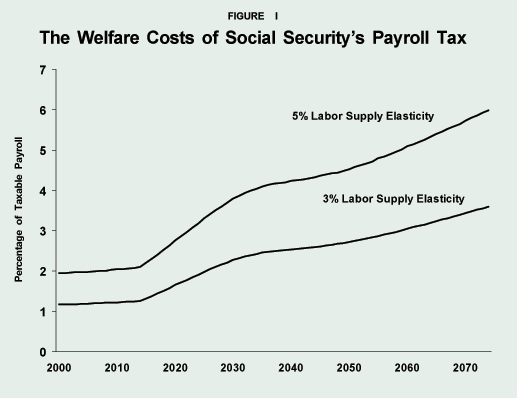
Note that using a pure tax rather than the statutory tax is a conservative approach that probably underestimates the burden of Social Security taxation for two reasons. First, the calculation of the pure tax is based on average benefits paid, rather than on marginal benefits generated by marginal taxes paid. As noted above, there is a loose relationship between a worker's expected benefits and the tax on the wages earned by the last hour of work. Second, our approach treats benefits promised years from now as if they are certain to be paid. In fact, due to uncertainty about future taxes and benefits, individuals may discount promised benefits at a higher rate than we assume and, if so, the pure tax rate would be higher.
Estimating Labor Responsiveness. Calculating the welfare loss requires an estimate of how responsive workers are to changes in their realized wages as a result of changes in the tax rates they face. Economists call this measure the labor supply elasticity.10 For this study, we need a measure of how responsive a worker's labor supply is to changes in wages while keeping the worker as well off at each wage. We use a low number of 0.3 and a high number of 0.5.11 Thus if the wage rate rises 10 percent, labor supplied will rise between 3 percent and 5 percent.
"The economic loss associated with the Social Security payroll tax last year was as much as 18 cents out of each $1 of taxes raised."
Estimating the Welfare Loss. The two final columns of Table I show the welfare costs of the payroll tax as a percent of wage earnings under alternative estimates of responsiveness of the labor supply to changes in wages. As these numbers show:
- The Social Security payroll tax caused a welfare loss between 1.17 percent and 1.95 percent of taxable wage earnings in 2001.
- These losses amount to 11 percent to 18 percent of the taxes raised; thus for every dollar in payroll tax revenues, society as a whole loses as much as 18 cents.
- For society as a whole, the loss amounted to between $49 billion and $82 billion in 2001, an amount equal to as much as $804 for every household in America.
Looking to the future, we find that the payroll tax required to pay benefits will rise and the welfare cost of the tax to the country as a whole will rise even faster:12 [See Figure I]
- By the time today's teenagers reach the retirement age in 2050, the nation will sacrifice as much as 30 cents in welfare for every dollar it collects in payroll taxes.
- By the time today's newborns retire in 2070, the loss will equal 34 cents for every dollar the government collects.
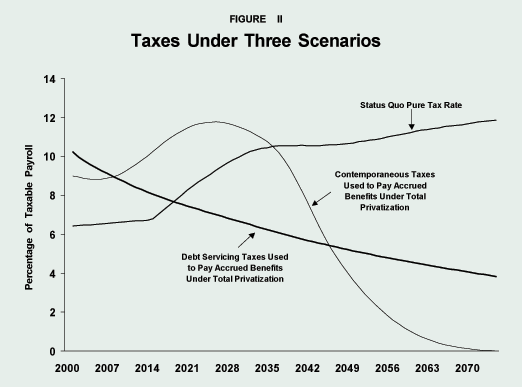
"Some countries, like Singapore are Chile, require workers to save for their own retirement."
As noted above, there is a loose link between marginal taxes paid and marginal benefits received under the U.S. Social Security system. The same is true of most pay-as-you-go social security systems in the world today. However, some countries have established mandatory savings programs as an alternative to pay-as-you-go social security. In these systems, workers are required to save for their own retirement. For example, Singapore has had such a system since the mid-1950s. Chile has had a mandatory savings alternative to pay-as-you-go social security since 1981. Currently, more than 20 countries mandate some form of individual retirement savings.13
In a mandatory savings system, when workers earn an extra dollar, they must place a portion of it in an account just as they pay FICA under the current U.S. system. However, unlike FICA taxes, funds placed in mandatory savings accounts are the individual workers' property, and the workers tend to view them as such. Thus when workers place funds in private accounts that earn the market rate of return, they tend not to view the contribution as a tax because they get to keep all they deposit.
Mandatory savings systems can also have welfare losses. The reason is that government may be requiring people to save more than they want to save. Put another way, a government may force people to allocate their lifetime consumption (between pre- and post-retirement years) differently than they wish. However, in what follows we assume that no welfare loss is associated with mandatory private savings, and we continue with the conservative assumption that the "pure Social Security tax" is the best way to measure the burden of the current system.
"Unlike Social Security taxes, funds placed in a mandatory savings account are an individual worker's private property."
The Potential Gain from Privatization. The net economic gain from privatization depends on a comparison of the welfare costs of the current system and the welfare costs after privatization. While the welfare costs of the current system indicate the potential gain from Social Security reform, not all welfare costs can be avoided. Over the years taxpayers and retirees have accumulated sizable benefits based on past participation in Social Security. We assume those accumulated or accrued benefits must continue to be paid, requiring either more debt or higher taxes or a combination of both. The additional debt or the higher taxes will continue to cause welfare losses.
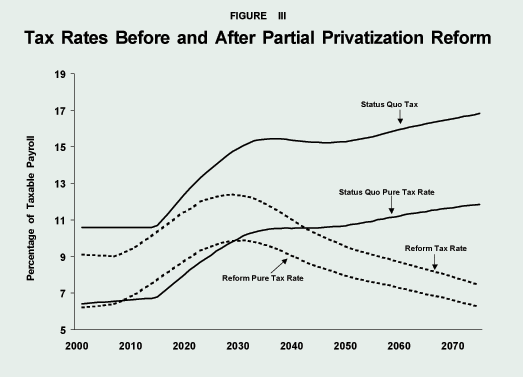
Many options exist for financing the accrued benefits after privatization, and we compare several of them to the current system. Our first two estimates are based on reforms that would result in total privatization of Social Security. We then follow the outline of one of the proposals suggested by the President's Commission to Strengthen Social Security and estimate welfare gains associated with partial prepayment.
Prepayment and Privatization. Prepayment and privatization of Social Security are often used interchangeably, when in fact they have separate meanings. Prepayment refers to saving now and using the proceeds of the saving to fund future Social Security expenditures. This saving can occur publicly, through a government-owned fund or privately through individually owned accounts. The unifying component is that the fund(s), regardless of who owns them, are invested in stocks and bonds and other assets. Prepayment can be partial or total. Partial prepayment involves advance funding of some but not all of future generations' Social Security benefits. With partial prepayment, future Social Security benefits are funded by taxes and by selling stocks and bonds. Total prepayment would require higher initial savings, but it would eventually allow all Social Security payroll taxes to be eliminated.
Privatization is a form of prepayment and refers to individually owned assets. Privatization can also be partial or full.14 Individually owned investment accounts, in the context of Social Security reform, are often referred to as Personal Retirement Accounts (PRAs). During retirement, the funds in the PRAs are used to pay all or part of the Social Security benefits workers expect to receive. When workers make deposits to PRAs they are prepaying their Social Security benefits.
"With complete prepayment, a payroll tax would no longer be necessary to pay benefits."
Total Privatization Using Government Bonds. Under this option, workers would receive recognition bonds15 equal to the present value of the future benefits they are entitled to, based on their earnings up to the year Social Security is reformed. From that point on, additional benefits would be financed with mandatory payroll deductions and deposits to PRAs. These funds would accumulate at the market rate of return.16 Following privatization, a payroll tax would no longer be necessary to pay benefits. However, some tax – we assume a payroll tax – would be necessary to service the additional debt (the new recognition bonds). Workers would view this entire tax as a pure tax given that it would have no bearing on the size of their own retirement benefits. Each year after this, a transitional payroll tax would pay the interest on the additional debt, keeping the absolute amount of the debt constant. Thus the only distortionary factor after privatization would be the transitional debt-servicing payroll tax.17
"If the transition to personal accounts is funded by issuing debt, by mid-century the reformed Social Security will have reduced the welfare loss of the current system by 60 percent."
To the extent that privatization leads to a reduction of the payroll tax, the PRA-based reform will improve efficiency and make workers better off. Our calculation of the welfare costs of the transitional payroll tax leads to the following conclusions:
- For the first two decades of the reform, the payroll tax needed to service the debt under the new system is higher than the pure tax rate under the current system. [Figure II.]
- Thus for the first 20 years or so, the welfare loss is actually higher under the reformed system.
- However, by mid-century, the reformed system will have cut the annual welfare loss under the current system by 60 percent. Appendix Table I.]
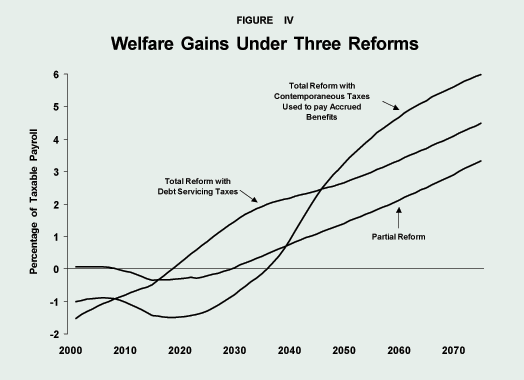
Total Prepayment with Tax Financing. Instead of issuing government debt, accrued benefits could be paid for through contemporaneous taxes as the benefits come due. In this case:
- The payroll tax needed in the new system would be higher than the pure tax in the current system for the first three decades of this century. [Figure II.]
- However, by mid-century, the welfare losses of the current system would be 72 percent less. [See Appendix Table II.]
"If the transition to personal accounts is funded by additional taxation, the tax rate would climb to 11.7 percent of payroll by 2026, but eventually fall to zero."
Unlike the debt-service tax, which declines over time, the contemporaneous taxes would rise until 2026 when they reach 11.7 percent of payroll. But as Figure II shows, they would eventually decline to zero. The contemporaneous transitional taxes are initially lower than the debt-servicing taxes under the previous scenario, but by 2009 they are higher. They remain higher until 2046 and then are always lower, reaching zero by 2075. The main difference then is the timing of the welfare cost reductions. With government bonds, the welfare gains are higher from 2009 to 2045, but with contemporaneous taxation the welfare gains in the future are higher.
Partial Prepayment with Contemporaneous Taxation. Most current Social Security reform proposals do not involve full prepayment of retirement benefits. Instead, they allow workers to set aside a portion of their payroll taxes under a mixed retirement system, partially prepaid and partially financed with taxes. Figure III depicts a mixed system involving PRAs based on 2 percent contributions. Specifically, we assume that all workers aged 55 and younger contribute to PRAs. At retirement, the PRA balances are annuitized and offset the worker's promised Social Security benefits dollar for dollar. During the accumulation period up to retirement, we assume the PRAs earn a real return of 4.6 percent. We assume the accounts are annuitized at a real return of 3.0 percent. We further assume that defined benefits are reformed in a manner similar to that suggested in the second option put forward by the President's Commission to Strengthen Social Security. In that option, beginning in 2009 and thereafter, the benefit formula is based on price-indexed earnings rather than wage-indexed earnings.18 In this way, real benefits are essentially set at their 2009 level.
"By the time today's newborns reach retirement age, personal accounts funded by 2 percent contributions would reduce the welfare loss of the current system by more than half."
Under these assumptions, Figure III shows the status quo, reform tax and pure tax rates. The pure tax component of the reformed system is initially slightly lower than that of the status quo, moves higher from 2009 to 2029, then again turns lower. The ultimate gains relative to the status quo are smaller than in the previous two scenarios, and for several decades the welfare costs are higher. The gains are smaller for two reasons. First, the portion of the payroll tax, viewed as a pure tax, is higher in the long run. Second, because the PRA reduces one's ultimate Social Security benefit payment, a higher share of the net tax payment is viewed as a pure tax by workers. Nonetheless, the reform is worthwhile:
- By mid-century, the reform would reduce the annual welfare loss of the current system by almost one-third (31 percent).
- By the time today's newborns reach retirement, it would reduce the welfare loss by more than half. [See Appendix Table III.]
A Recap. Figure IV depicts the welfare gains, as a percentage of taxable payroll, associated with the three reforms discussed above. Total privatization using contemporaneous taxes to pay the accrued benefits has the highest up-front costs and produces the greatest long-run gains. Partial prepayment, through a reform similar to one suggested by the President's Commission to Strengthen Social Security, results in a modest increase in the welfare cost for 20 years but ultimately produces a welfare gain equal to about 3 percent of taxable payroll.
[page]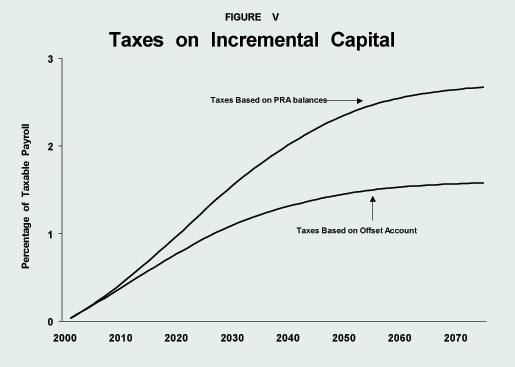
While reducing the size of the welfare cost associated with labor supply distortions, prepaying Social Security also increases the size of the nation's means of production, what economists call the capital stock. Because promised Social Security benefits funded by pay-as-you-go financing displace savings, the nation's capital stock is smaller than it would be in the absence of the system. The $12 trillion to $14 trillion of accumulated benefits owed to current retirees and current workers based on their participation in the program as of 2001 is a rough estimate of the degree to which the capital stock is currently diminished by the presence of Social Security.
"Funds in personal accounts would also add to the nation's capital stock."
With partial prepayment similar to that we just discussed, the capital stock will rise by the amount by which future government debts are reduced. Both wage price indexation and benefit offsets reduce the debt. As a result, the accumulated balance in PRAs can be thought of as additions to the capital stock, with the amount in the offset accounts reflecting a conservative estimate of the additions to the capital stock.
As the capital stock rises, it produces earnings, or returns on capital. These returns, adjusted for inflation, recently have been estimated at 8.5 percent of the underlying capital. The 8.5 percent reflects pretax returns, before corporate taxes at the federal, state and local levels. Some earnings on the incremental capital due to the reform are taxed away before they show up in individual PRA accounts. Since after-tax returns are used to estimate the effects of PRAs on the system's financing, the corporate taxes can be redirected to Social Security. Figure V indicates the taxes that can be recaptured, measured as a percent of taxable payroll. By 2050 these taxes are between 1.5 percent an 2.4 percent of payroll.
[page]The Social Security payroll tax has a negative effect on labor supply and the overall output of goods and services. We estimate that the welfare cost of this effect is currently between 1.17 and 1.95 percent of taxable wages. By 2070 the cost will rise to between 3.39 percent to 5.64 percent without reform. These losses are equal to between one-fifth and one-third of the taxes raised.
This welfare cost is distinct from the low rate of return from Social Security itself. The low rates of return current and future workers expect to receive on their Social Security contributions are a consequence of the system's pay-as-you-go financing and the early participants' windfall gains. The presence of the substantial difference between the return earned from Social Security contributions and the return that could be earned in the capital market suggests that the Social Security tax is indeed a net tax on payroll that distorts labor supply decisions and causes a welfare loss.
"By 2070 the Social Security payroll tax will have a negative effect equal to as much as one-third of taxes raised."
The three reform scenarios we evaluated all produce long-run welfare gains. The more complete the reform, in terms of the amount of prefunding, the greater are these gains. In the first two scenarios involving total privatization, as private accounts are funded and accrued debts are paid, the welfare costs are higher than the status quo. But these higher costs produce substantial long-run benefits. In the last scenario, based on partial prepayment, welfare losses are ultimately reduced by more than 50 percent.
Further, as we mentioned in the introduction, the Social Security system causes other distortions. Incorporating these additional distortions would make the total welfare cost of the current system several times the estimate reported in this paper.
"The huge implicit debts of the current system significantly crowd out private investment."
First, the huge implicit debts of the current system significantly crowd out private investment. Because workers expect Social Security pensions when they retiree, they save less than they otherwise would. This has a devastating effect on the nation's capital stock, income and growth and a negative welfare effect due to the distortion in the capital market caused by taxes on capital income. The capital income tax is like the payroll tax in that it drives a wedge between the return individuals receive when they invest in the capital market and the returns to society. For each dollar in reduced savings, individuals lose only the after-tax rate of return, but society loses the gross rate of return in reduced future consumption. This is an additional welfare loss.
Second, the payroll tax skews the forms of compensation offered to workers. Remuneration tilts from taxable wages to untaxed fringe benefits and workplace amenities and causes a distortion similar to the one we analyze in this study. In the case of the labor supply, the payroll tax discourages work and encourages leisure. In the case of varying forms of compensation, the payroll tax encourages excessive nontaxable benefits.
"When all costs are considered, society bears as much as a $3 cost for every $4 the system pays out in benefits."
Third, because the payroll tax reduces disposable income, it tends to reduce individual savings as well. These negative savings effects could have significant welfare costs due to the distortion in the capital market caused by the taxes on capital incomes. In the presence of preexisting taxes, the saver does not bear the entire loss from reduced savings. Thus associated with each unit reduction in savings arising from the reduction in disposable income, there is a welfare loss – usually in the form of reduced tax revenue from the capital income taxes. Note that this welfare cost from reduced savings caused by the Social Security tax, though sharing a similar mechanism, is different from and in addition to the Social Security wealth's crowding-out effect on saving. Basically, the crowding-out effect comes from workers' perceived future Social Security benefits as "wealth." The Social Security tax's negative effect on saving comes from the fact that workers have less to save.
We estimate that each of the above distortions is of the same magnitude as the labor supply distortion caused by the Social Security payroll tax.19 Thus the total annual welfare cost was roughly 4.7 percent to 7.8 percent of aggregate wage earnings in 2001, or as much as $326 billion. In comparison, Social Security benefits equaled $439 billion last year. This sizable loss is also the potential economic gain promised by a swift reform of the current system. With any of the reforms outlined in this paper, real and favorable changes will take place only after privatization. Each type of reform – partial or full, debt- or tax-financed – produces different gains and has different generational consequences. However, with individuals saving and working more, the nation will have more resources to provide for consumption by the elderly. Not only will reform solve the financing problem and secure retirement benefits, it will also reduce the welfare cost associated with the current system – making both current and future generations better off.
[page]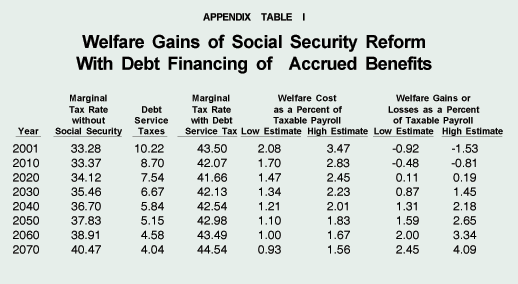
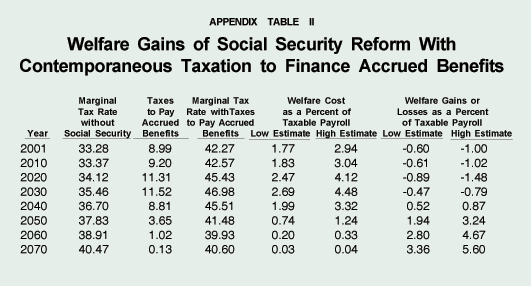
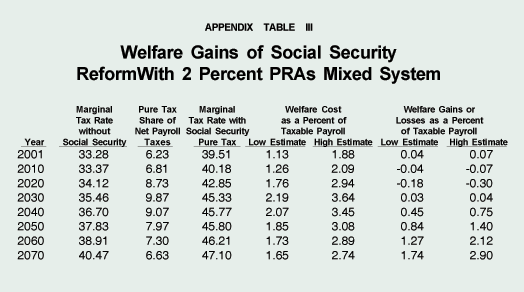
- These opposing forces can perfectly offset each other so that observed hours of work are unchanged after the tax. A payroll tax is a proportional tax because it rises in proportion to the hours of work. For a worker who earns $10 per hour, a payroll tax of 15 percent reduces the hourly take-home pay to $8.50. Suppose the worker worked 40 hours per week before the tax was levied, making $400. After the tax the worker realizes that each hour of work is worth only $8.50 in take-home pay. This gives him the incentive to work less. At the same time, however, the worker wants to put food on the table, so the tax also gives him the incentive to work more. These effects work in opposite directions so that the hours of work may be more, less or the same after the tax as before. The important point is that the worker is made worse off by the payroll tax in excess of the tax revenues collected. This excess burden of the tax, over and above the tax revenues collected, is the welfare loss.
- This estimate is derived from data on federal individual income tax returns. See David Hoffman, "Who Pays the Federal Income Tax?" Tax Foundation, Table 1, February 2002, Special Report No. 109. The estimate is a weighted average of the marginal tax rates at different levels of adjusted gross income. The marginal tax rate of 20.15 percent is higher than the average tax rate of 14.8 percent. It reflects the tax on an additional dollar of income.
- The Social Security program as a whole provides retirement pensions, survivors benefits and disability benefits. The Old-Age and Survivors Insurance (OASI) is currently funded by a dedicated tax of 10.6 percent of taxable payroll. The Disability Insurance portion is currently funded by a dedicated payroll tax of 1.8 percent of payroll.
- However, the effective marginal OASI tax rate is below the statutory level due to the formula linking Social Security taxable wages to future benefits, as will be discussed below.
- See Edgar K. Browning, "On the Marginal Welfare Cost of Taxation," American Economic Review, Vol. 77, 1987, pp. 11-23, and Edgar K. Browning, "The Marginal Social Security Tax on Labor," Public Finance Quarterly, Vol. 13, 1985, pp. 227-51, for discussions of the marginal tax rate on labor income. Browning (1987) used a range of 38 percent to 48 percent to identify the total welfare cost of taxes on labor. Martin Feldstein, "Tax Avoidance and the Deadweight Loss of the Income Tax," Review of Economics and Statistics, Vol. 31, No. 4, November 1999, pp. 674-80, used a range of 38.9 percent to 42.5 percent.
- James M. Poterba, "The Rate of Return on Corporate Capital and Factor Shares: New Estimates Using Revised Income and Product Accounts and Capital Stock Data," National Bureau of Economic Analysis, NBER working paper No. 6263, April 1999, estimated the pretax real rate of return on non-financial corporate capital at 8.5 percent. After accounting for corporate taxes at the federal, state and local level, the return falls to about 5.4 percent.
- This is based on the growth in the taxable wage base from the intermediate assumptions in The 2001 Annual Report of the Board of Trustees of the Federal Old-Age and Survivors Insurance and Disability Insurance Trust Funds, Washington, D.C.
- Steven Caldwell et al., "Social Security's Treatment of Postwar Americans," National Bureau of Economic Analysis, NBER Working Paper No. 6603, June 1998.
- For our estimates, we first calculate the pure tax share for each birth year and the proportion of total annual income earned by members of each birth year, and then determine what proportion of that total the pure tax represents. These proportions are used to weight the groups' pure tax share to arrive at the annualized pure tax.
- It identifies the percentage change in labor supplied divided by the percentage change in wages.
- Existing estimates of this responsiveness range from 0.2 to above 0.6. See the Appendix for additional discussion of the compensated labor supply responses used here.
- The welfare loss rises to between 2.69 percent and 4.48 percent by 2050, and to 3.39 percent and 5.64 percent of taxable earnings by 2070. For consistency with later estimates and with the recently issued report of the President's Commission to Strengthen Social Security, we use a 4.6 percent real rate of return rather than the 5.4 rate. The lower rate assumes a 50/50 split between equities and bonds. The assumed real equity yield is 6.5 percent, the corporate bond yield is 3.5 percent and the government bond yield is 3.0. The bond share is split 60 percent corporate and 40 percent government bonds. Administrative expenses are assumed to be 0.3 percentage points.
- Estelle James, "Social Security Reform Around the World: Lessons from Other Countries," forthcoming, National Center for Policy Analysis.
- Privatization in our usage requires individual ownership or claims on productive assets. Note that the government could also issue each Social Security participant a bond that guarantees future benefits and privatizes, or more accurately "individualizes," the ownership. This individualization does not result in prepayment.
- Bonds issued to current taxpayers and retirees equal to the present value of their accrued benefits "recognize" or denominate the implicit Social Security debt and are referred to as recognition bonds.
- The contribution rate necessary to prepay scheduled Social Security benefits varies with rate of return assumptions. With a 5.4 real return during both the accumulation phase and the annuitization phase, the contribution rate is on average 4.1 percent of taxable earnings. With the more conservative rate used here, 4.6 during the accumulation phase and 3 percent during the annuity phase, the contribution rate is 6.2 percent.
- Using a payroll tax to service the debt produces a conservative estimate of the welfare gain. As Laurence J. Kotlikoff has suggested, using a business cash-flow tax to finance the costs of accrued benefits will lower the welfare costs that were due to the payroll tax. Besides reducing the welfare costs, the broader base also distributes some of the burden to the older generation. See Laurence J. Kotlikoff, "Privatizing Social Security the Right Way," Independent Review, Vol. 5, No. 1, Summer 2000, pp. 55-63.
- The Social Security benefit formula currently indexes or translates past earnings into present values using a wage index. In so doing, real wage growth and price growth both affect the size of past earnings when they are indexed to the present. With price indexing alone, indexed earnings are smaller than wage indexed earnings, and as a result benefits are smaller. However, price indexing is phased in so that real benefits for new retirees after 2009 remain the size of those earned by new retirees in 2009. The commission's second option actually allows for contributions to personal accounts equal to 4 percent of wages up to $1,000. Though we use 2 percent on wages up to the taxable maximum our simulations provide a reasonable approximation of the change in the welfare costs associated with the Commission's second proposal.
- See Martin Feldstein, "The Missing Piece in Policy Analysis: Social Security Reform," American Economic Review, Vol. 86, No. 1, 1996, pp. 1-14, for a discussion of the magnitude of the welfare cost from Social Security wealth's crowding out of private savings; see Martin Feldstein, "Tax Avoidance and the Deadweight Loss of the Income Tax," Review of Economics and Statistics, No. 4, Vol. 81, November 1999, pp. 674-80, for an estimate of the welfare cost from the income tax's distortion to the form of compensation as compared to its distortion to labor supply; see Edgar K. Browing and William R. Johnson, "The Cost of Reducing Economic Inequality," Cato Journal, Vol. 6, No. 1, Fall 1986, pp. 85-109, for a discussion of the magnitude of the welfare cost from income tax's savings effect as compared to its distortion of the labor supply.
- Edgar K. Browning, "On the Marginal Welfare Cost of Taxation," American Economic Review, Vol. 77, 1987, pp. 11-23.
- Browning, ibid., 1987, also interpreted this welfare triangle as equal to the increase in earnings if the marginal tax rate is reduced to zero (but with the worker kept on the same indifference curve), abl1l0, less the value of leisure given up in generating that increment in earnings, adl1l0.
Dr. Liqun Liu is an Assistant Research Scientist at the Private Enterprise Research Center. His primary research areas are taxation analysis and evaluation of government expenditures. His current focus is on the effects of reforming elderly entitlements. Dr. Liu serves as an investigator on several research grants. He has papers published in National Tax Journal, Economic Inquiry, Journal of Institutional and Theoretical Economics, and Review of Economic Design.
Dr. Andrew J. Rettenmaier is the Executive Associate Director at the Private Enterprise Research Center at Texas A&M University. His primary research areas are labor economics and public policy economics with an emphasis on Medicare and Social Security. Dr. Rettenmaier and the Center's Director, Thomas R. Saving, have presented their Medicare Reform proposal to U.S. Senate Subcommittees and to the National Bipartisan Commission on the Future of Medicare. Their proposal has also been featured in the Wall Street Journal, New England Journal of Medicine, Houston Chronicle and Dallas Morning News. Dr. Rettenmaier is the co-principal investigator on several research grants and also serves as the editor of the Center's two newsletters, PERCspectives on Policy and PERCspectives. He is co-author of a book on Medicare, The Economics of Medicare Reform (Kalamazoo, Mich.: W. E. Upjohn Institute for Employment Research, 2000), and is an editor of Medicare Reform: Issues and Answers. (The University of Chicago Press, 1999).